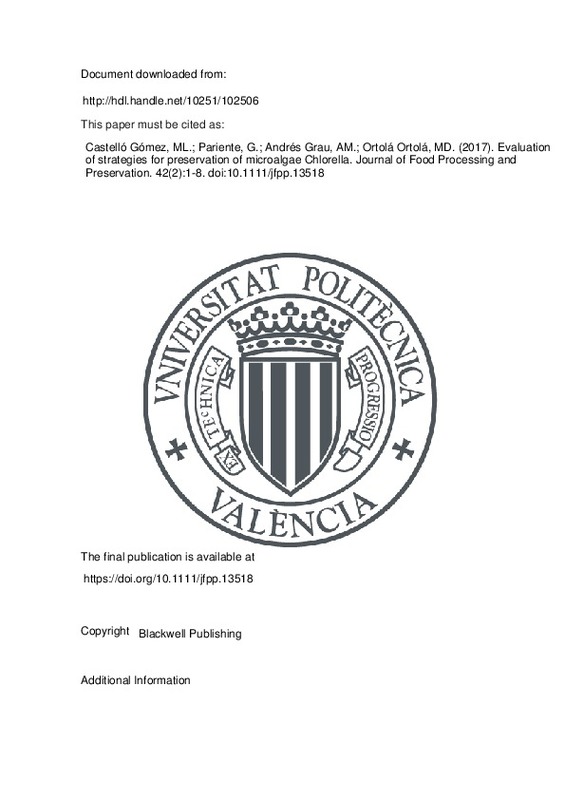JavaScript is disabled for your browser. Some features of this site may not work without it.
Buscar en RiuNet
Listar
Mi cuenta
Estadísticas
Ayuda RiuNet
Admin. UPV
Evaluation of strategies for preservation of microalgae Chlorella
Mostrar el registro sencillo del ítem
Ficheros en el ítem
| dc.contributor.author | Castelló Gómez, María Luisa
|
es_ES |
| dc.contributor.author | Pariente, G.
|
es_ES |
| dc.contributor.author | Andrés Grau, Ana María
|
es_ES |
| dc.contributor.author | Ortolá Ortolá, Mª Dolores
|
es_ES |
| dc.date.accessioned | 2018-05-24T04:25:51Z | |
| dc.date.available | 2018-05-24T04:25:51Z | |
| dc.date.issued | 2017 | es_ES |
| dc.identifier.issn | 0145-8892 | es_ES |
| dc.identifier.uri | http://hdl.handle.net/10251/102506 | |
| dc.description.abstract | [EN] The biomass obtained from microalgae, such as Chlorella, is used to make dietary products, supplements and pharmaceuticals. However, microalgae are produced very far from consumption places. One of the most usual distribution forms is as a dry product, a process that entails high production costs and leads to the loss of certain nutritional properties. Therefore, the aim of this study was to evaluate alternative preservation strategies for microalgae Chlorella other than dehydration and freezing. To that end, sterilization, acidification, and packaging material were analyzed during 2 months of storage under different temperature and light exposure conditions. The results showed that color was modified considerably by sterilization, regardless of light exposure and type of package, whereas citric acid preserved color, especially at low storage temperatures. Furthermore, the study shows that acidification with 3.5% of citric acid and vacuum packaging are the recommended treatment for microalgae, without the need for cold storage. Practical applicationsStabilization of microalgae Chlorella from production to consumption places could increase the possibilities of commercialization of this product, recently labeled superfood by the UN Food and Agriculture Organization. In order to preserve all their nutritional properties for at least 2 months, acidification with 3.5% of citric acid and vacuum packaging are the recommended treatments, without the need for cold storage. | es_ES |
| dc.description.sponsorship | The review of this paper was funded by the Universitat Politècnica de València, Spain | en_EN |
| dc.language | Inglés | es_ES |
| dc.publisher | Blackwell Publishing | es_ES |
| dc.relation.ispartof | Journal of Food Processing and Preservation | es_ES |
| dc.rights | Reserva de todos los derechos | es_ES |
| dc.subject.classification | TECNOLOGIA DE ALIMENTOS | es_ES |
| dc.title | Evaluation of strategies for preservation of microalgae Chlorella | es_ES |
| dc.type | Artículo | es_ES |
| dc.identifier.doi | 10.1111/jfpp.13518 | es_ES |
| dc.rights.accessRights | Abierto | es_ES |
| dc.date.embargoEndDate | 2019-02-01 | es_ES |
| dc.contributor.affiliation | Universitat Politècnica de València. Departamento de Tecnología de Alimentos - Departament de Tecnologia d'Aliments | es_ES |
| dc.description.bibliographicCitation | Castelló Gómez, ML.; Pariente, G.; Andrés Grau, AM.; Ortolá Ortolá, MD. (2017). Evaluation of strategies for preservation of microalgae Chlorella. Journal of Food Processing and Preservation. 42(2):1-8. doi:10.1111/jfpp.13518 | es_ES |
| dc.description.accrualMethod | S | es_ES |
| dc.relation.publisherversion | https://doi.org/10.1111/jfpp.13518 | es_ES |
| dc.description.upvformatpinicio | 1 | es_ES |
| dc.description.upvformatpfin | 8 | es_ES |
| dc.type.version | info:eu-repo/semantics/publishedVersion | es_ES |
| dc.description.volume | 42 | es_ES |
| dc.description.issue | 2 | es_ES |
| dc.relation.pasarela | S\346385 | es_ES |
| dc.contributor.funder | Universitat Politècnica de València |







![[Cerrado]](/themes/UPV/images/candado.png)

